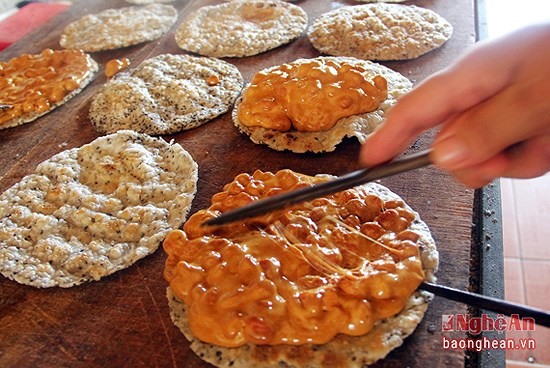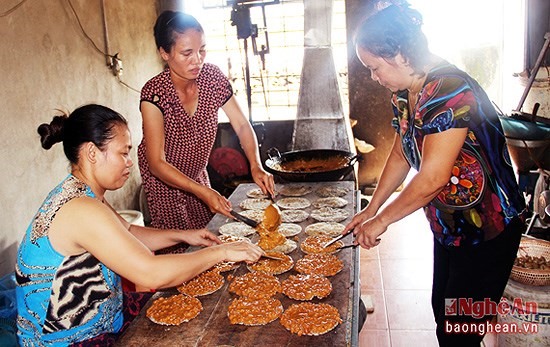Viet Nam News
Ha Nguyen
Each locality in Viet Nam has its own specialty. Hai Duong has its dau xanh (green been cake) and Cao Bang has its banh khao (sweet short cake made of roast glutinous rice flour). In Ha Tinh, the specialty is cu do, a candy made of roasted peanuts and molasses and covered with rice pancakes.
The name cu do appeared long ago in Ha Tinh’s Huong Son region, said 90-year-old Ho Vinh.
There are several stories related to the candy’s name. One person said that in the era of French domination, the candy was made by an old man named Hai. Locals called him "cu Hai". When the French troops arrived at his shop, they enjoyed the candy but struggled to pronounce the old man’s name. The misunderstanding led to a combination of the French deux (two) with the man’s nickname.
Cu do from elderly Hai was known far and wide for its quality – not too soft and not too hard, said Vinh.
But another village elder, Phan Toan, said a poor farmer in Ha Tinh had nothing to offer his neighbours at his son’s wedding except sugar cane and ground nuts. The son’s name was Do so villagers often called him "cu Do" (cu is a popular local nickname for a young boy).
 |
| Technique: The final process of wrapping cu do in between two rice pancakes. |
The father roasted the nuts, boiled the sugar cane and mixed it all together. The food was delicious and the villagers enjoyed it so much that they named it after the son, said Toan.
No matter what its origin, the candy is made of popular materials from rural Ha Tinh, harmoniously combined to reflect the area’s natural characteristics and local life. It is a food enriched with the simplicity of the native land, said Vinh.
A quality candy should merge the buttery taste of peanut, the sweetness of sugar cane, the fiery fragrance of fresh ginger and the crispness of the pancake. Vinh said that making a crispy and tasty cu do is not simple.
“We have to choose yellow cane molasses, small but sweet groundnuts which are still in their shells without mould tailings,” said Vinh. “But the most important step is the cooking technique. The molasses should be carefully boiled, then cut ginger and roasted peanuts are stirred in. The cooker has to ensure the peanuts do not sink to the bottom of the pot or else they could burn.”
 |
| Tradition: Candy makers at Ha Tinh’s well known Dai Nai Village produce cu do. |
When fragrant smells rise from the pot, the candy maker uses chopsticks to drop a little molasses into cold water. If the drop maintains its round shape, that means the cu do is finished cooking. Before scooping the cooked mix onto the pancake, the cooker may choose to add several pieces of malt to make the flavour more aromatic and the texture smoother. Finally a second pancake is added as a cover.
“It is great to enjoy cu do with a cup of fresh green tea which is of yellow colour with strong and sweet tartness,” said Vinh.
When asked why cu do is so sweet and tough, Vinh said that in the past, the central region – including Ha Tinh – was very poor because its barren land suffers severe heat and frequent flooding and storms, forcing locals to save a bit to survive. They made cu do tough so nobody would be able to eat too much at once.
Benefiting from the country’s doi moi (renewal) policy since 1986, living standards of Vietnamese people including locals in Ha Tinh have been improving steadily. Cu do makers have also improved their cooking technique, said Vinh.
 |
| Modern presentation: Packaging cu do candy at a workshop. |
In the past, cu do was covered by banana leaves that made the treat difficult to enjoy. The leaves would stick to the molasses.
Although cu do came into being in Huong Son’s My Hoa Village, Dai Nai Village (locally known as cu do village) is more famous for the candy because most households there make it.
Oversea Vietnamese Duong Quoc Khanh from Ukraine, whose family once lived in Ha Tinh, said that each time he returned to Viet Nam for business, he ordered cu do to bring home as gifts for his relatives and friends.
“We, Ha Tinh people, consider our cu do candy our native land’s soul for its simplicity, austerity and sweetness,” Khanh said. “It inspires us with emotions to remember to our barren land, but it is also cosy and full of sentimentality for local people.” — VNS